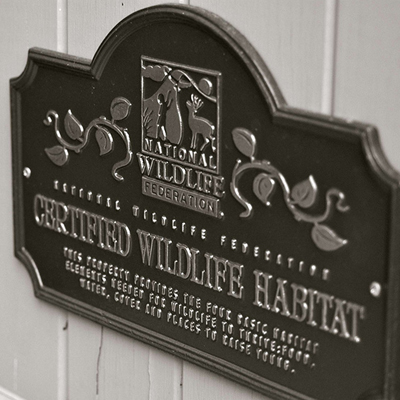
Certified Wildlife Habitat
Our office is located at a certified wildlife habitat.
This quote brings to you the essence of what Dr. Bonine has set out to accomplish on this land. His philosophy is that business can contribute to the preservation and enhancement of natural areas, as well as provide a relaxing and peaceful place for all. He has bypassed the "perfect lawn" for a more natural look, thereby preserving space for wildlife and providing for their needs. His "rustic enhancement" concept brings habitat enhancement together with typical landscaping practices. With less and less open space available, as our urban environments gulp up these areas, here is a model for many others to follow—whether at home or at a place of work. This property exhibits the key components for sound backyard habitat improvements. They include:
- Providing a diversity of plants
- Providing the basic needs for wildlife : food, water, shelter & space
- Use of energy conservation practices
- Use of soil conservation practices
- Providing function; i.e., trees with berries for wildlife
- Providing arrangement
- Providing natural beauty
Let's explore and see some of the unique qualities that this "enhanced" property, which once was a dairy farm, has to offer as a model. Today, it is in the process of reclaiming itself with the help of plantings that will benefit a wide variety of wildlife. Take a few moments to relax, enjoy the tranquil setting, and observe the natural wonders found here.
The wildflower plantings along the driveway have taken the place of mowing. This reduces the amount of resources needed to maintain the area. With a lawn, people have the tendency to want it to look it's best, so they use lots of water, as well as pesticides and herbicides to make it "perfect". These additions destroy the plants and animals, which naturally exist and interrupt the natural cycle. The roadside wildflowers provide homes and food for many insects, mammals and birds.
The courtyard is designed to meet the needs of wildlife.
Can you find any plants that would provide for butterflies, birds or small mammals? The design of this area gives one a good idea of the important elements needed for wildlife habitat improvement.
- Evergreen Trees and Shrubs
Evergreen trees and shrubs provide wind protection for butterflies which visit the flowers, protection for birds who come to feed, and also buffer the sights and sounds from the nearby roads. Seeds or berries provide food for mice and birds. Twigs and buds may be eaten by deer in the winter.
- Nectar Flowers
Nectar flowers such as columbine, yellow lilies, and clematis vine provide nectar for a wide variety of butterfly species.
- Rocks
Rocks provide landing pads and sun-basking areas for butterflies. The rocks give escape areas for small mammals and insects.
- Grasses
Grasses provide a source of seeds for many birds, mice and voles. Many butterfly caterpillars depend on grasses for their main food.
- Hummingbird Feeders
Hummingbird feeders attract hummingbirds to the area for viewing. These feeders assist hummingbirds in the spring in gaining energy for their long flight north, and in the fall for their flight south.
- Bird Feeders
Bird feeders attract seed-eating birds to areas where you can view their courtship and feeding behaviors. In severe weather, such as an ice storm, feeders help birds to obtain food. Only approximately 30% of a bird's food would come from a feeder. The natural plants of grasses and seed bearing plants give them their main food source.
Take a few moments to view the area and relax.
Take in the sights and sounds. This could be your backyard or business. Think of all you could provide for wildlife, with less time and energy wasted on the pursuits of a "perfect lawn."
If one were to imagine what this property once looked like as a dairy farm, it is hard to believe that today one would find such a wide variety of plants and animals living here. Through careful planning and enhancement of the natural landscape, this property has become more diverse and exhibits sound wildlife habitat improvement and protection.
"People need a model. If they can see a place become beautiful, they're inspired to act." -Marion Stoddart
Resources for Wildlife Habitat Improvement
Kalamazoo Nature Center, Community Wildlife Program
P.O. Box 127 Kalamazoo, MI 49004 (616) 381-1574
National Wildlife Federation: Backyard Wildlife Habitat Program
Regional Office, Ann Arbor, Michigan
Michigan State University Cooperative Extension Service, Master Gardener Program
Look in your local phonebook under your county government listings
Books
Landscaping for Wildlife
Minnesota Department of Natural Resources
500 Lafayette Rd, Box 7
St. Paul, MN 55155 (800) 657-3757
Birdscaping Your Garden: A Practical Guide to Backyard Birds and Plants That Attract Them, George Adams, Rodale Press, Inc.
– This text was prepared by the Kalamazoo Nature Center.

